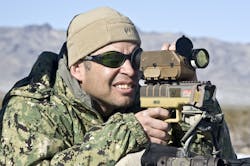Marine Corps asks Northrop Grumman to build NGHTS electro-optical handheld laser target designation system
QUANTICO, Va. – Electro-optical targeting systems experts from the U.S. Marine Corps needed a portable system to help Marines acquire targets quickly on the battlefield. They found their solution from the Northrop Grumman Mission Systems segment in Apopka, Fla.
Officials of the Marine Corps Systems Command at Quantico Marine Base, Va., announced a $252 million eight-year contract to Northrop Grumman on Thursday for the Next Generation Targeting Handheld System (NGHTS).
NGHTS is a lightweight man-portable system that enables Marines to acquire targets quickly; perform guidance against targets; and generate target location data during combat operations. NGHTS will combine target location, laser spot imaging, and laser target designation.
The contract includes low-rate initial production, full-rate production, testing, spare parts, engineering services, logistics support, training, and documentation.
The Marines today use four legacy systems: the Portable Lightweight Designator Rangefinder, Joint Terminal Attack Controller, Laser Target Designator and Thermal Laser Spot Imager. The intent is for NGHTS to replace all four systems.
The NGHTS handheld targeting system will combine all of the legacy capabilities into one system that is compatible with current and future fire-support systems, and will support the Marine Corps for the next 15 to 20 years. NGHTS will reduce the weight of Marine Corps laser designation and laser spot imaging capability by 60 percent, experts say.
In December 2018 the Marine Corps awarded four other transaction authorities (OTAs) to BAE Systems, Elbit Systems of America, Fraser Optics, and Northrop Grumman for the first phase of the NGHTS program. The OTAs were to evaluate contractor ability to produce NGHTS, and gain insights into the best possible system.
In early 2015 The Marine Corps awarded a $73.4 million contract to Elbit Systems of America in Merrimack, N.H., to build as many as 1,500 Common Laser Range Finder-Integrated Capability (CLRF-IC) handheld tactical laser rangefinders, which are small enough for individual Marine infantrymen to carry.
The handheld CLRF-IC handheld laser rangefinder systems are to help deployed Marines detect, identify, and pinpoint targets during the day, at night, and in bad weather.
On the NGHTS contract Northrop Grumman will do the work in Apopka, Fla., and should be finished by February 2030. For more information contact Northrop Grumman Mission Systems online at www.northropgrumman.com.

John Keller | Editor-in-Chief
John Keller is the Editor-in-Chief, Military & Aerospace Electronics Magazine--provides extensive coverage and analysis of enabling electronics and optoelectronic technologies in military, space and commercial aviation applications. John has been a member of the Military & Aerospace Electronics staff since 1989 and chief editor since 1995.

